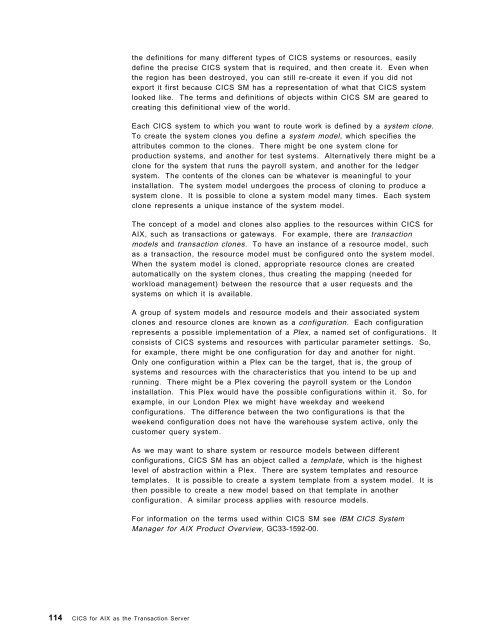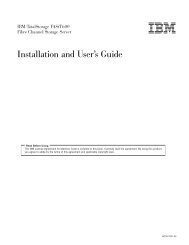Addressing OLTP Solutions with CICS: The Transaction Server ... - Ibm
Addressing OLTP Solutions with CICS: The Transaction Server ... - Ibm
Addressing OLTP Solutions with CICS: The Transaction Server ... - Ibm
Create successful ePaper yourself
Turn your PDF publications into a flip-book with our unique Google optimized e-Paper software.
114 <strong>CICS</strong> for AIX as the <strong>Transaction</strong> <strong>Server</strong><br />
the definitions for many different types of <strong>CICS</strong> systems or resources, easily<br />
define the precise <strong>CICS</strong> system that is required, and then create it. Even when<br />
the region has been destroyed, you can still re-create it even if you did not<br />
export it first because <strong>CICS</strong> SM has a representation of what that <strong>CICS</strong> system<br />
looked like. <strong>The</strong> terms and definitions of objects <strong>with</strong>in <strong>CICS</strong> SM are geared to<br />
creating this definitional view of the world.<br />
Each <strong>CICS</strong> system to which you want to route work is defined by a system clone.<br />
To create the system clones you define a system model, which specifies the<br />
attributes common to the clones. <strong>The</strong>re might be one system clone for<br />
production systems, and another for test systems. Alternatively there might be a<br />
clone for the system that runs the payroll system, and another for the ledger<br />
system. <strong>The</strong> contents of the clones can be whatever is meaningful to your<br />
installation. <strong>The</strong> system model undergoes the process of cloning to produce a<br />
system clone. It is possible to clone a system model many times. Each system<br />
clone represents a unique instance of the system model.<br />
<strong>The</strong> concept of a model and clones also applies to the resources <strong>with</strong>in <strong>CICS</strong> for<br />
AIX, such as transactions or gateways. For example, there are transaction<br />
models and transaction clones. To have an instance of a resource model, such<br />
as a transaction, the resource model must be configured onto the system model.<br />
When the system model is cloned, appropriate resource clones are created<br />
automatically on the system clones, thus creating the mapping (needed for<br />
workload management) between the resource that a user requests and the<br />
systems on which it is available.<br />
A group of system models and resource models and their associated system<br />
clones and resource clones are known as a configuration. Each configuration<br />
represents a possible implementation of a Plex, a named set of configurations. It<br />
consists of <strong>CICS</strong> systems and resources <strong>with</strong> particular parameter settings. So,<br />
for example, there might be one configuration for day and another for night.<br />
Only one configuration <strong>with</strong>in a Plex can be the target, that is, the group of<br />
systems and resources <strong>with</strong> the characteristics that you intend to be up and<br />
running. <strong>The</strong>re might be a Plex covering the payroll system or the London<br />
installation. This Plex would have the possible configurations <strong>with</strong>in it. So, for<br />
example, in our London Plex we might have weekday and weekend<br />
configurations. <strong>The</strong> difference between the two configurations is that the<br />
weekend configuration does not have the warehouse system active, only the<br />
customer query system.<br />
As we may want to share system or resource models between different<br />
configurations, <strong>CICS</strong> SM has an object called a template, which is the highest<br />
level of abstraction <strong>with</strong>in a Plex. <strong>The</strong>re are system templates and resource<br />
templates. It is possible to create a system template from a system model. It is<br />
then possible to create a new model based on that template in another<br />
configuration. A similar process applies <strong>with</strong> resource models.<br />
For information on the terms used <strong>with</strong>in <strong>CICS</strong> SM see IBM <strong>CICS</strong> System<br />
Manager for AIX Product Overview, GC33-1592-00.
















